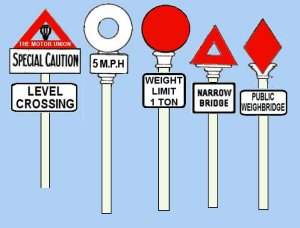 |
| source - North-West Evening Mail |
When I blogged back in July about the restoration of some traditional finger post road signs in the village of Glanton, Northumberland, I ended that post with an expression of gladness that such work was still being carried out, that it was inspiring other communities to do the same and that I hoped another eight years would not elapse before a similar news item came up again for me to mention on here (having previously posted about an antique 1904 road sign in Overstrand, Norfolk, in 2012). Well I'm happy to say that a mere four months separate the Glanton article from this next, comparable story from the charming Cumbrian village of Cartmel, which lies just north of Morecambe Bay between the towns of Barrow-in-Furness and Kendal.
 |
| source - Wikimedia Commons |
In this instance the signs are of the "bladed" village name variety as opposed to the directional finger post designs featured in the previous post. Dating back even further to the Victorian era, some are even as old as 1837. In other respects though they are largely identical to the later types as seen in Glanton, being of cast iron construction and painted in contrasting black and white to stand out clearly on the rural highway for the weary traveller to see - a role they performed admirably for over a century and which they continue to do today despite the advent of the newer Warboys designs in the 1960s.
As with the Glanton fingerposts the Cartmel signs - four of them dotted around and on the outskirts of the village - have been afforded a new lease of life, ensuring their continued survival well into the future, thanks again to the efforts of the parish council and in this case the services of local lengthsman Archie Workman (surely one of the best examples of nominative determinism I've seen in a long while) and a fellow unnamed road sign enthusiast with a passion for restoring these few remaining links to past travel. (As an aside this article has been a welcome source of education for your author as it is the first time I've come across the term "lengthsman", which I've discovered is a traditional old English term dating back to beyond the 18th century used to describe anyone employed by parish councils or local landowners to keep a "length" of road clear and passable and which I'm delighted to learn is a job still being carried out today by the likes of Mr Workman.)
 |
| source - Twitter / @OldSignPainter |
This sterling work is just one part of Mr Workman's aim to restore all such remaining signposts in the Furness area - 26 in all (including another seven around Cartmel), featuring the age-old Lancastrian blade and nipple-top design and originally produced by local steelworkers Thomas Graham & Sons of Preston (who I'm pleased to see are still operating). It is again wonderful to see these vintage road signs appreciated by locals and visitors alike; that there are still people out there with the interest and more importantly the skills to ensure that they can continue to be both enjoyed and made use of in their original function. I hope and believe that other local parish councils will be equally as keen as Allithwaite and Cartmel to see their Victorian-era village signs restored to their former glory by Mr Workman and his colleagues and I wish them every success in their time-honoured work.










